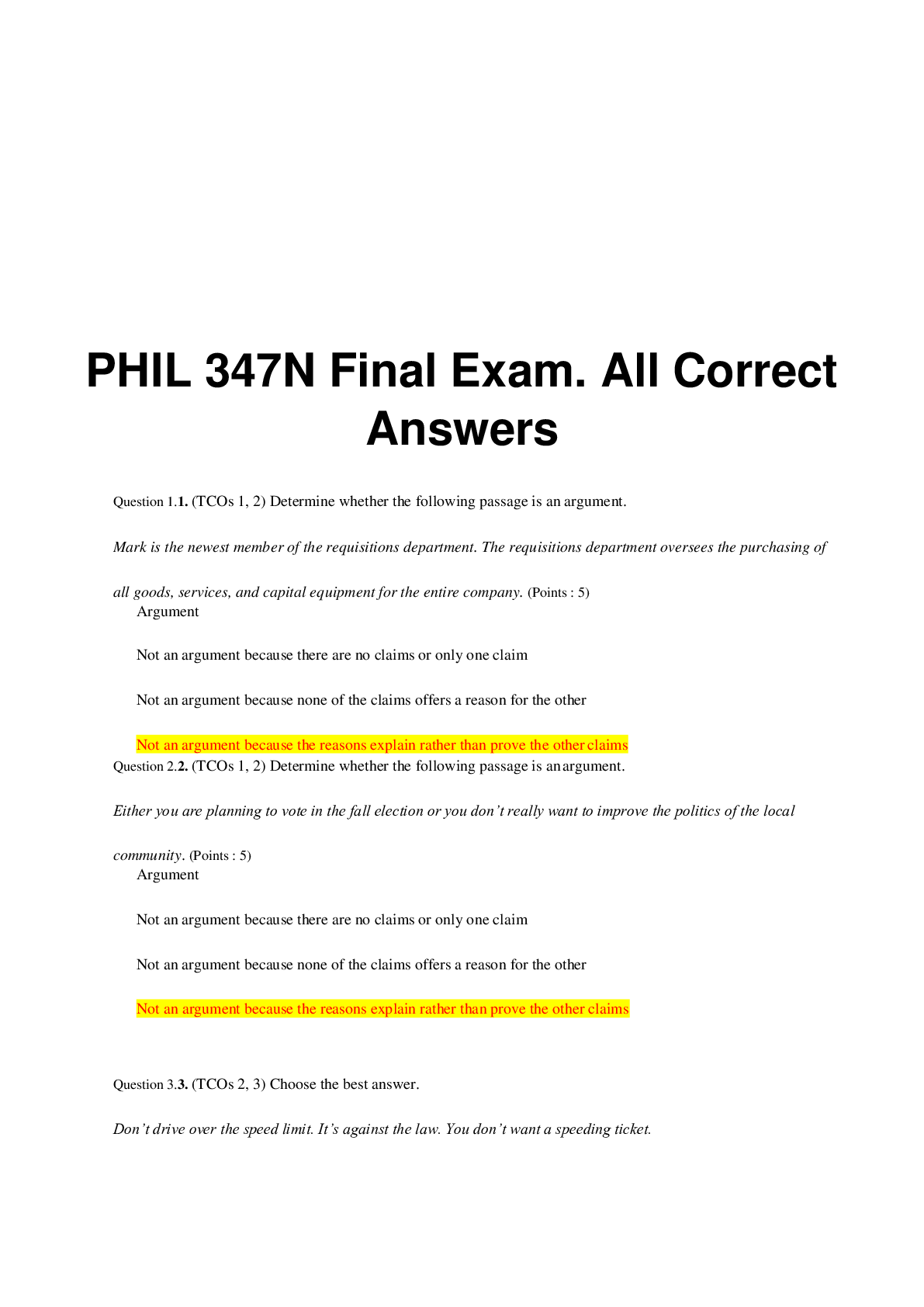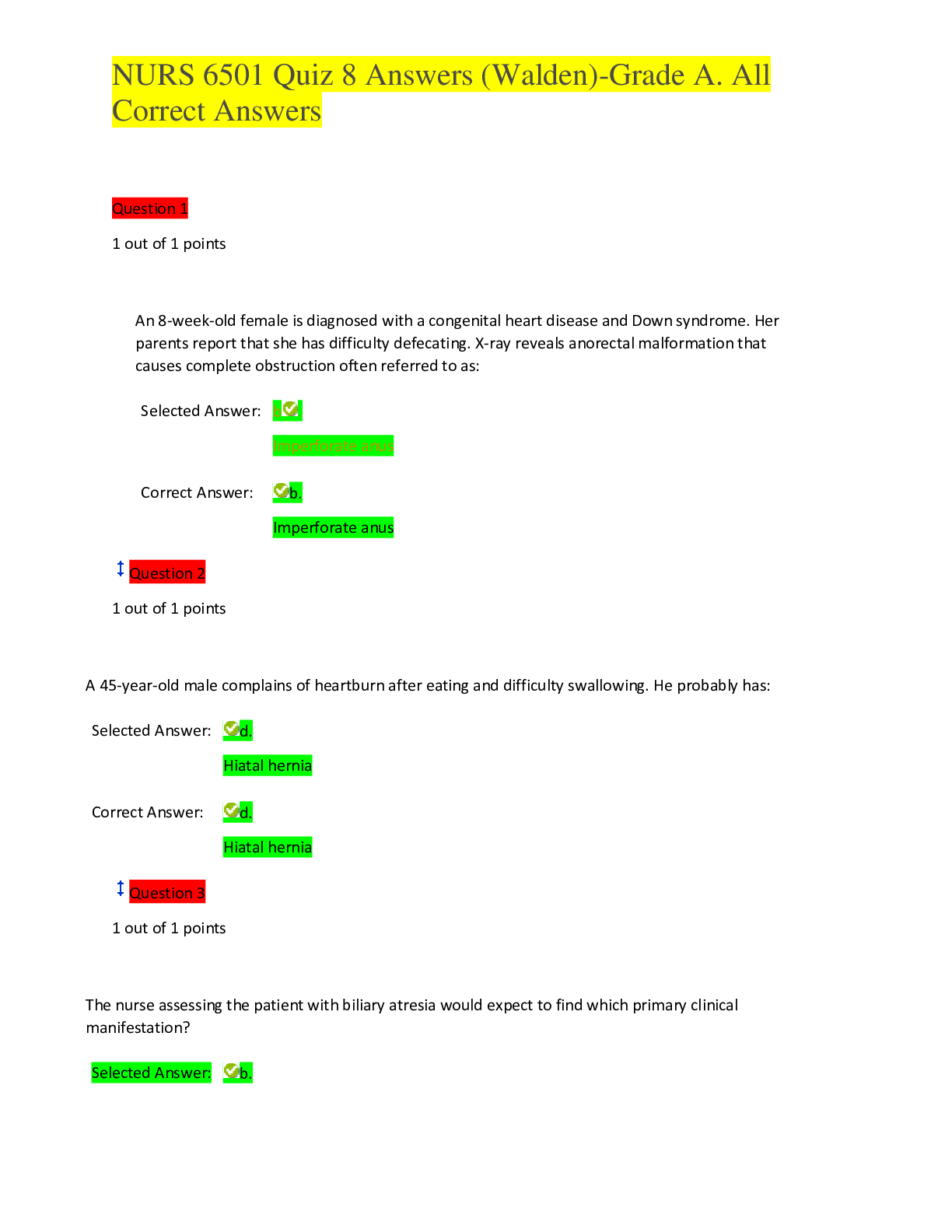*NURSING > QUESTIONS & ANSWERS > NUR 6501 week 4 quiz.docx test questions with all correct answers updated new docs (All)
NUR 6501 week 4 quiz.docx test questions with all correct answers updated new docs
Document Content and Description Below
NUR 6501 week 4 quiz.docx test questions with all correct answers updated new docs Question 1 1 out of 1 points A 68-year-old female is experiencing left heart failure. Physical exam reveals e... levated blood pressure. The nurse understands this is most likely caused by: Question 2 1 out of 1 points A 52-year-old male is diagnosed with primary hypertension. He has no other health problems. Present treatment would cause the nurse to anticipate administering which drug to the patient? Question 3 1 out of 1 points A 65-year-old female presents to the emergency department reporting difficulty swallowing and shortness of breath. A CT scan would most likely reveal an aneurysm in the: Question 4 1 out of 1 points A 32-year-old female presents with lower leg pain, with swelling and redness. While obtaining the patient’s history, which finding could have caused her condition? Question 5 1 out of 1 points A patient wants to know what causes atherosclerosis. How should the nurse respond? In general, atherosclerosis is caused by: Question 6 1 out of 1 points Which of the following findings in the patient with Raynaud disease would indicate a need for further teaching? Question 7 1 out of 1 points An 82-year-old female was admitted to the hospital with confusion and severe hypotension. Her body’s compensatory mechanisms are increased heart rate, vasoconstriction, and movement of large volumes of interstitial fluid to the vascular compartment. What kind of shock does the nurse suspect the patient is experiencing? Question 8 1 out of 1 points A 50-year-old male is diagnosed with orthostatic hypotension. Which of the following symptoms would he most likely experience? Question 9 1 out of 1 points A 70-year-old female is in the hospital for pelvic fracture. She develops pulmonary thromboembolism. The nurse realizes this embolus is composed of: Question 10 1 out of 1 points A 52-year-old female is diagnosed with coronary artery disease. The nurse assesses for myocardial: Question 11 1 out of 1 points A 60-year-old male is diagnosed with cerebral aneurysm. Where does the nurse suspect the cerebral aneurysm is located? Question 12 1 out of 1 points A 50-year-old male with a 30-year history of smoking was diagnosed with bronchogenic cancer. He developed edema and venous distention in the upper extremities and face. Which of the following diagnosis will the nurse observe on the chart? Question 13 1 out of 1 points A 50-year-old male visits the cardiologist for an EKG. Results indicate that he has no PR interval and a variable QRS rate with rhythm irregularity. Which of the following is the most likely diagnosis to be recorded on the chart? Question 14 1 out of 1 points A 52-year-old male presents with pooling of blood in the veins of the lower extremities and edema. The diagnosis is chronic venous insufficiency, and an expected assessment finding of this disorder is: Question 15 0 out of 1 points While planning care for a patient with superior vena cava syndrome (SVCS), which principle should the nurse remember? SVCS is a progressive _____ of the superior vena cava (SVC) that leads to venous distention of the upper extremities and head. Question 16 1 out of 1 points A 28-year-old female presents with severe chest pain and shortness of breath. She is diagnosed with pulmonary embolism, which most likely originated from the: Question 17 1 out of 1 points What term should the nurse document for a detached blood clot? Question 18 1 out of 1 points A 65-year-old male is diagnosed with chronic pulmonary disease and elevated pulmonary vascular resistance. Which of the following heart failures should the nurse assess for in this patient? Question 19 1 out of 1 points A 50-year-old obese male with hypertension and coronary artery disease visits a nutritionist for food counseling. He has an elevated level of low-density lipoprotein (LDL) and a low level of high-density lipoprotein (HDL). Which of the following should the nurse advise him to avoid? Question 20 1 out of 1 points A 50-year-old male is diagnosed with pulmonary embolism (PE). Which of the following symptoms most likely occurred before treatment? Question 21 1 out of 1 points When a nurse checks the patient for orthostatic hypotension, what did the nurse have the patient do? Question 22 1 out of 1 points A 50-year-old female presents with a low heart rate and low blood pressure. She is given an intravenous (IV) infusion of fluids. The increase in atrial distension results in: Question 23 1 out of 1 points Which of the following patients is at highest risk for developing pulmonary embolism (PE)? Question 24 1 out of 1 points A 51-year-old male is at the health clinic for an annual physical exam. After walking from the car to the clinic, he developed substernal pain. He also reported discomfort in his left shoulder and his jaw, lasting 2 to 3 minutes and then subsiding with rest. He indicates that this has occurred frequently over the past few months with similar exertion. The nurse suspects he is most likely experiencing: Question 25 1 out of 1 points A 56-year-old male is diagnosed with coronary artery disease. Which of the following modifiable risk factors would the nurse suggest the patient change? Question 26 1 out of 1 points A 30-year-old Caucasian female was recently diagnosed with primary hypertension. She reports that she eats fairly well, usually having red meat and potatoes daily. She also reports that her father has hypertension as well. A nurse determines which of the following risk factors is most likely associated with this diagnosis? Question 27 1 out of 1 points An 80-year-old female is in the hospital for a bone fracture. While there she develops a large, nonlethal pulmonary embolus. Which of the following is a direct result of the obstruction to pulmonary blood flow? Question 28 1 out of 1 points A 35-year-old male presents with pulmonary hypertension. Testing reveals he is in right heart failure. Which of the following is the most likely diagnosis the nurse will see listed on the chart? Question 29 1 out of 1 points A 54-year-old male is diagnosed with left bundle branch block. Which of the following structures would not receive an electrical impulse? Question 30 1 out of 1 points A 65-year-old male is transported to the ER for chest pain. An electrocardiogram reveals a prolonged QRS interval. What is the nurse monitoring when the nurse observes the QRS complex on the electrocardiogram? The QRS complex reflects: [Show More]
Last updated: 2 years ago
Preview 1 out of 8 pages
.png)
Buy this document to get the full access instantly
Instant Download Access after purchase
Buy NowInstant download
We Accept:

Reviews( 0 )
$12.00
Can't find what you want? Try our AI powered Search
Document information
Connected school, study & course
About the document
Uploaded On
Feb 13, 2021
Number of pages
8
Written in
Additional information
This document has been written for:
Uploaded
Feb 13, 2021
Downloads
0
Views
96

 answers.png)
























